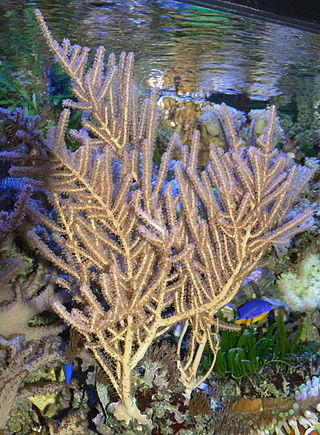
Xenia is a genus of photosynthetic soft marine coral in the family Xeniidae. They resemble a mushroom, with "arms" coming out from the top that ends in many-fingered "hands". It is unique among corals because of its ability to use its "hands" to "pulse" or push water away from the colony in a constant, grabbing motion. Common names include fast-pulse Xenia. Species of Xenia are sometimes referred to as pulse corals.

Octocorallia is a class of Anthozoa comprising over 3,000 species of marine organisms formed of colonial polyps with 8-fold symmetry. It includes the blue coral, soft corals, sea pens, and gorgonians within three orders: Alcyonacea, Helioporacea, and Pennatulacea. These organisms have an internal skeleton secreted by mesoglea and polyps with eight tentacles and eight mesentaries. As with all Cnidarians these organisms have a complex life cycle including a motile phase when they are considered plankton and later characteristic sessile phase.

Keratoisis is a genus of deep-sea bamboo coral in the family Isididae, containing the following species:

Holaxonia is a suborder of soft corals, a member of the phylum Cnidaria. Members of this suborder are sometimes known as gorgonians and include the sea blades, the sea fans, the sea rods and the sea whips. These soft corals are colonial, sessile organisms and are generally tree-like in structure. They do not have a hard skeleton composed of calcium carbonate but have a firm but pliable, central axial skeleton composed of a fibrous protein called gorgonin embedded in a tissue matrix, the coenenchyme. In some genera this is permeated with a calcareous substance in the form of fused spicules. Members of this suborder are characterized by having an unspiculated axis and often a soft, chambered central core. The polyps have eight-fold symmetry and in many species, especially in the families Gorgoniidae and Plexauridae, contain symbiotic photosynthetic algae called zooxanthellae. These soft corals are popular in salt water aquaria.

Nephtheidae is a family of soft corals in the phylum Cnidaria. Members of this family are known as carnation corals, tree corals or colt soft corals. They are very attractive and show a wide range of rich and pastel colours including reds, pinks, yellows and purples. They are popular with reef aquarium hobbyists.

Gersemia is a genus of soft corals in the family Nephtheidae. Species in this genus are found in cold temperate and polar seas at depths ranging from 20 metres (66 ft) to over 2,000 metres (6,600 ft). The type species is Gersemia loricata.

Dendronephthya is a genus of soft corals in the family Nephtheidae. There are over 250 described species in this genus. They are sometimes kept in aquariums, but are notoriously difficult to keep, requiring a near constant supply of small foods such as phytoplankton.

Alcyonium is a genus of soft corals in the family Alcyoniidae and class octocorallia. Alcyonium generally called as dead men's finger.

Eleutherobia is a genus of soft corals in the family Alcyoniidae.

Primnoidae is a family of soft corals.

Plexauridae is a family of marine colonial octocorals in the phylum Cnidaria. Members of this family are found in shallow tropical and subtropical seas. Many species contain symbiotic photosynthetic protists called zooxanthellae.

Capnella is a genus of soft corals in the family Nephtheidae. They are also commonly known as Kenya tree corals.

Siphonogorgia is a genus of soft corals in the family Nidaliidae. Like other members of this family, these corals do not contain symbiotic zooxanthellae.

Anthomastus is a genus of soft corals in the family Alcyoniidae.

Clavularia is a genus of corals in the family Clavulariidae. They are often referred by the common names star polyps or clove polyps.

Anthelia is a genus of soft corals in the family Xeniidae.

Litophyton is a genus of soft corals in the family Nephtheidae.

Sarcophyton is a genus of corals in the family Alcyoniidae that are commonly kept in reef aquaria. Sarcophyton produces the toxic terpene macrolide sarcophytoxide which serves as an antifeedant and also provides advantage in competition with other corals as it reduces photosynthesis of the coral Acropora formosa. However, snail Ovula ovum eats Sarcophyton, probably detoxifying sarcophytoxide in the intestines.

Narella is a genus of deep-sea soft corals in the family Primnoidae (Milne Edwards, 1857). They are sessile, bottom-dwelling organisms that can be found in all ocean basins, having cosmopolitan distribution. They have a branching appearance.

Paralemnalia is a genus of corals belonging to the family Nephtheidae.





















